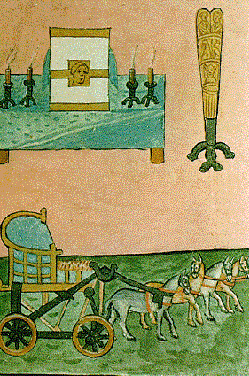 Contents -
Previous Article -
Next Article
Contents -
Previous Article -
Next Article
Symbols of Authority and Power
Listed below and on the following pages are some of the government offices in the late Roman bureaucracy. The illustrations shown describe the official insignia of some of these offices. They are from a medieval copy of the NOTITIA DIGNITATVM, a register of Roman government and military magistrates. The illustrations of the insignia of office are highly symbolic. The most important symbol of office was the codicil, a letter from the emperor which was framed in gold and ivory and set upon a special table with a coverlet. Some officials had a tall silver inkstand with three legs as part of their insignia. The inkstand symbolizes jurisprudence and indicates that the magistrate was competent in legal matters. In addition to the inkstand and codicil, praetorian prefects had candlesticks and an open carriage as part of their insignia.
The COMES SACRARVM LARGITONVM., or Count of the Sacred Largesse is another one of the high officials in the Late Roman Government whose insignia of office are illustrated in the Notitia Dignitatum. This official was a member of the imperial Consistory, or Privy Council, and was in charge of the imperial government treasury. His job was to oversee the collection of taxes and the paying out of money by the Roman government. The symbols of his office included gold and silver coins, bags of coins with symbols of their value on them, and other wealth in a form that was easy to distribute and store.
Go to next article:
Go back to previous article:
Please Note: This article is grouped with both The Roman Government and The Later Roman Empire topics.
Return to The later Roman Empire Table of Contents
Return to Roman Government Table of Contents
 Contents -
Previous Article -
Next Article
Contents -
Previous Article -
Next Article